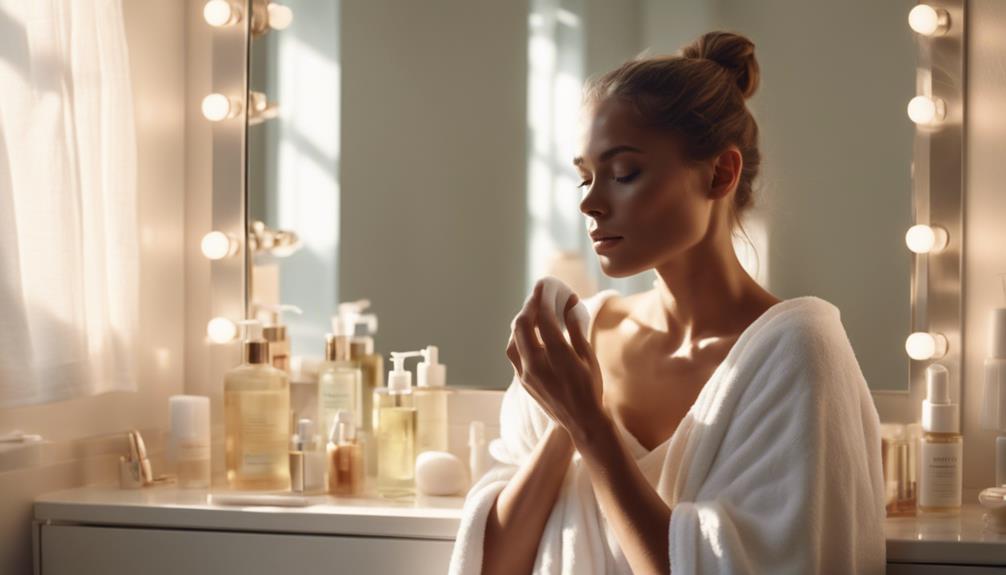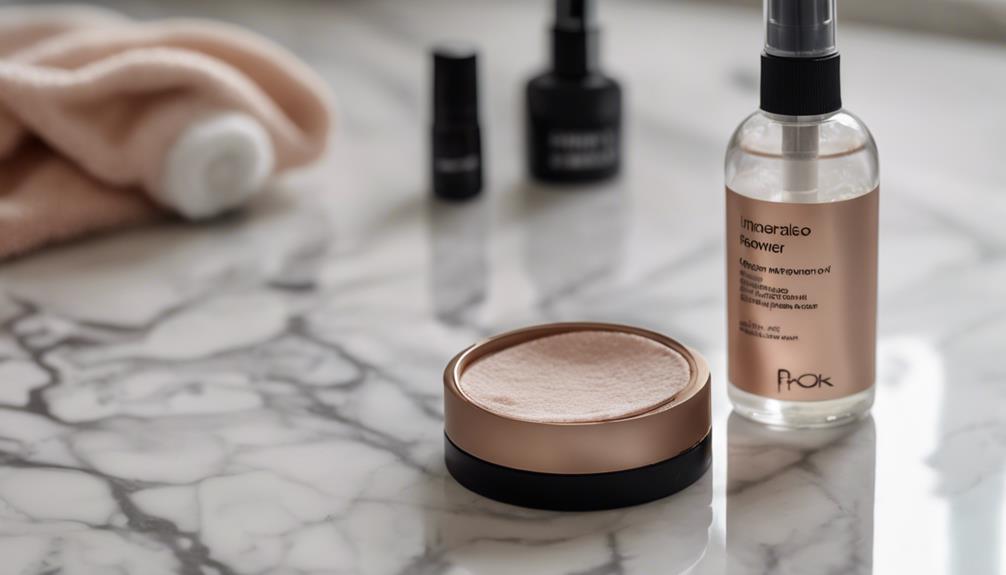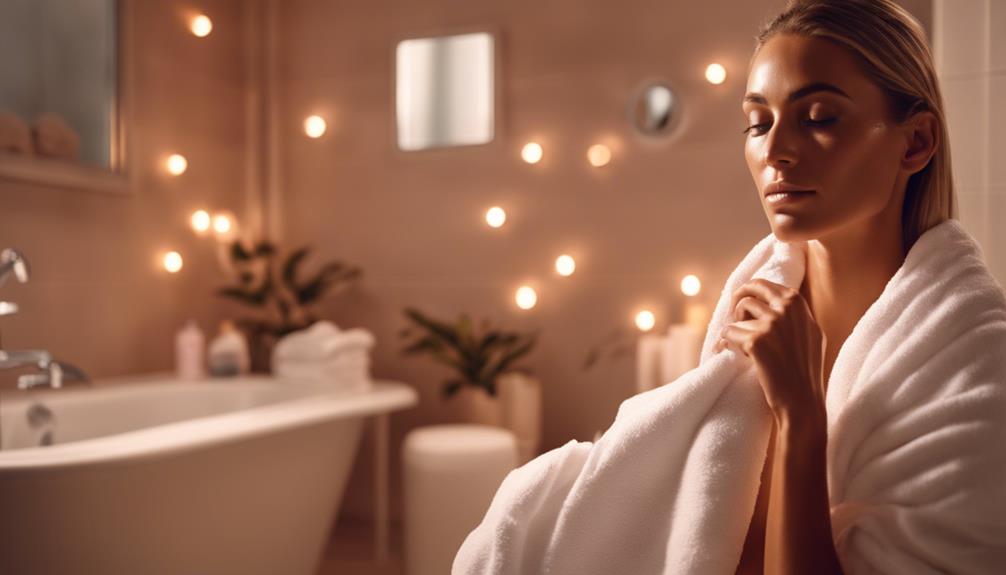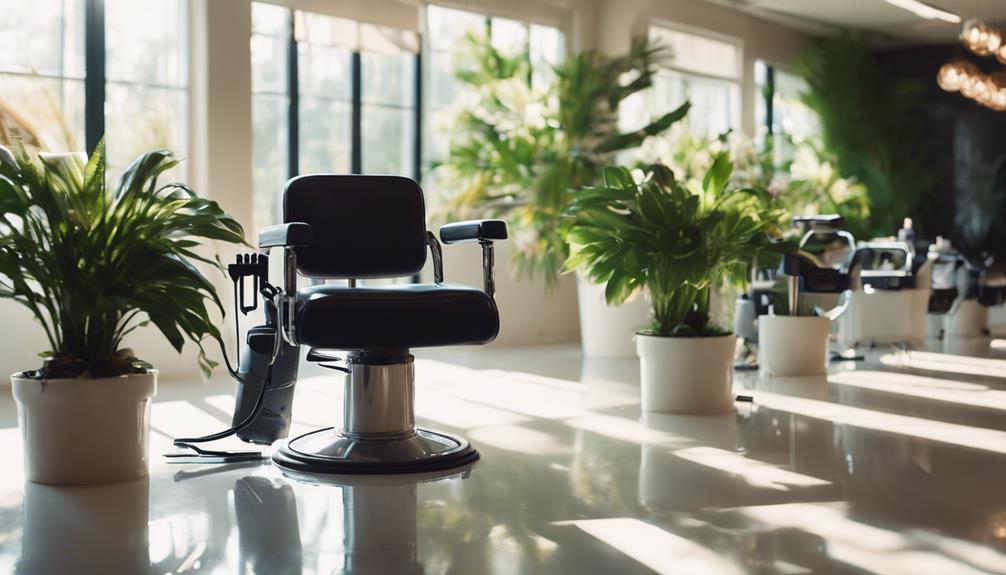To achieve a flawless spray tan, effective makeup removal is key. Start with a gentle makeup remover like micellar water to cleanse your skin. For stubborn makeup, follow up with an oil-based remover. Next, cleanse your face with a mild facial cleanser and rinse with lukewarm water. Verify all residue is gone to avoid uneven color. Before tanning, lightly exfoliate and hydrate your skin, focusing on any dry areas. Avoid applying deodorant or lotion right before your spray tan for the best results. Stick around to discover more tips for maintaining that sun-kissed glow!
Key Takeaways
- Use a gentle makeup remover like micellar water to effectively cleanse your skin before tanning.
- Follow up with an oil-based remover for stubborn makeup to ensure complete removal.
- Cleanse your face with a mild facial cleanser to eliminate any remaining impurities.
- Lightly exfoliate your skin to remove dry patches without using harsh scrubs that can irritate.
Importance of Makeup Removal
Removing makeup before your spray tan is essential to guarantee a smooth, even application and to avoid any unwanted streaks.
Makeup creates a barrier that prevents the tanning solution from properly absorbing into your skin, leading to patchy, uneven color. If you leave leftover makeup on your skin, it can also clog your pores and result in breakouts after your tan.
To achieve the best results, make sure to remove all makeup thoroughly before your appointment. Use gentle cleansers or micellar water for light makeup, and for stubborn products, an oil-based remover works wonders.
Prioritizing makeup removal not only enhances your tan's appearance but also promotes healthier skin, ensuring you look your best.
Effective Cleansing Techniques
To guarantee your skin is ready for a flawless spray tan, employing effective cleansing techniques is key.
Start by using a gentle makeup remover, like micellar water, to dissolve foundation, mascara, and other products. This first step ascertains you're not left with any residue.
For stubborn makeup, follow up with an oil-based remover, which breaks down heavier products without irritating your skin.
After makeup removal, cleanse your face with a mild facial cleanser to eliminate any remaining impurities. Rinse well with lukewarm water, as hot water can dry out your skin.
Skin Preparation Steps

Before you apply your spray tan, prepping your skin properly is essential for achieving a smooth, even application.
Start by gently cleansing your face and body with a mild makeup remover, like micellar water, to eliminate any leftover makeup.
Next, lightly exfoliate your skin to remove dry patches, but avoid harsh scrubs that can irritate.
Make certain to hydrate your skin by applying a lightweight moisturizer, focusing on dry areas such as elbows and knees.
Remember not to apply deodorant or lotion right before tanning, as these can create barriers and lead to uneven results.
Following these steps guarantees your skin is primed for a flawless and radiant spray tan.
Post-Tan Makeup Tips
Applying makeup after a spray tan requires patience to guarantee the tan sets properly and lasts longer. Wait at least 6-8 hours before reaching for foundation or powder to allow the tanning solution to fully develop.
When you do apply makeup, choose shades that complement your new glow; lighter products like gel bronzers and creamy blushes work best.
Hydrate your skin with oil-free, fast-absorbing moisturizers to keep the tan vibrant. Avoid applying makeup immediately after tanning to prevent uneven fading.
Mistakes to Avoid

Neglecting to remove makeup prior to your spray tan is a major mistake that can lead to uneven color and disappointing results. Makeup creates a barrier, preventing the tanning solution from evenly absorbing into your skin.
You should also avoid showering right before your tan, as it can result in dark spots and uneven application. Skipping proper exfoliation of dry areas can cause patchy results, so make certain to lightly exfoliate beforehand.
Don't forget to follow a strict 'dos and don'ts' list to guarantee ideal results. Finally, allow your tan to settle by avoiding showers for at least 6-8 hours post-application.
Maintaining a Long-Lasting Tan
How can you maintain a long-lasting tan? By using gentle self-tanners and keeping your skin hydrated, you'll guarantee your glow lasts longer. Here are some essential tips to help you retain that sun-kissed look:
| Tip | Description | Frequency |
|---|---|---|
| Hydrate | Drink plenty of water and use moisturizer daily. | Daily |
| Gentle Exfoliation | Lightly exfoliate to remove dead skin cells. | Once a week |
| Avoid Hot Showers | Hot water can strip your tan; opt for lukewarm. | Every shower |
| Use a Tan Extender | Apply a tan extender for a boost of color. | Every few days |
Trending Tanning Topics

With a long-lasting tan in mind, many are exploring trending tanning topics to enhance their sun-kissed glow and address common challenges.
You might find discussions around the latest spray tan equipment particularly helpful, as technology keeps evolving to deliver better results.
Safety tips for tanning bed users are also gaining attention, ensuring you stay informed while achieving that perfect tan.
Healthy alternatives to tanning beds are trending too, such as natural self-tanners that provide a beautiful, sun-kissed look without harmful UV exposure.
Additionally, techniques to tackle common issues like white armpits are circulating in the tanning community, helping you maintain an even and radiant tan.
Staying updated on these topics will keep your tanning game strong!
Frequently Asked Questions
Can I Use Makeup Wipes Instead of Cleanser for Removal?
You can use makeup wipes, but they might not remove all makeup effectively. For better results, follow up with a gentle cleanser to guarantee your skin's completely clean and ready for the next steps.
How Do I Know if My Makeup Is Fully Removed?
Like a painter prepping a canvas, you'll know your makeup's fully removed when your skin feels fresh and bare. Check for residue by gently swiping a cotton pad; if it's clean, you're good to go!
What if I Have Sensitive Skin?
If you have sensitive skin, choose gentle, hypoallergenic makeup removers. Avoid harsh ingredients, and consider patch testing new products. Always follow up with a soothing toner or moisturizer to calm and hydrate your skin.
Should I Remove Makeup Immediately Before Tanning?
Oh sure, keep that makeup on! Who doesn't love a splotchy, uneven tan? Seriously, you should remove it right before tanning. It guarantees the solution absorbs properly, giving you that flawless glow you crave.
Is It Necessary to Remove Eye Makeup Separately?
Yes, you should remove eye makeup separately. It often requires a gentler approach, so use a dedicated eye makeup remover. This guarantees everything comes off completely, preventing any barriers for a smooth spray tan application.
Conclusion
In summary, never underestimate the power of proper makeup removal before your spray tan!
It's the secret sauce for achieving that golden, sun-kissed glow you've always dreamed of. By following these tips, you set yourself up for tanning success and keep your skin looking fabulous.
Remember, a flawless tan can make you feel like a million bucks, so don't skip this vital step. Embrace the prep, and get ready to shine brighter than the sun!









